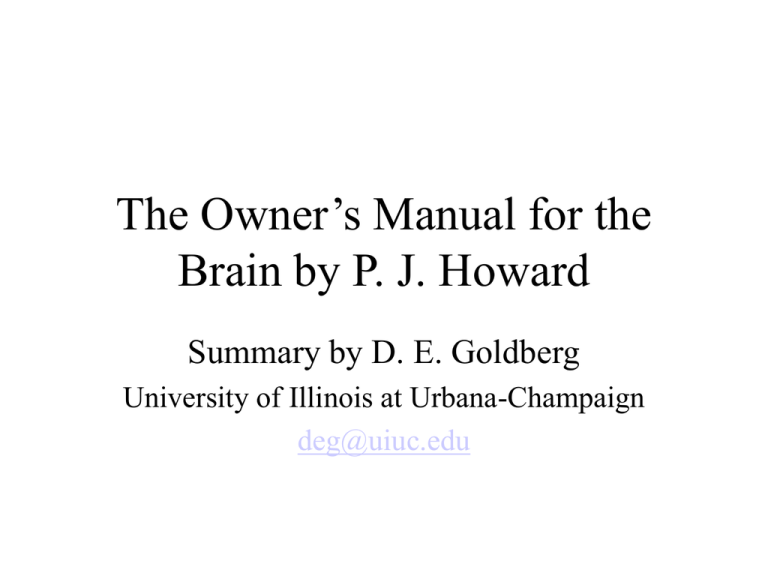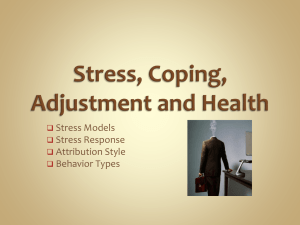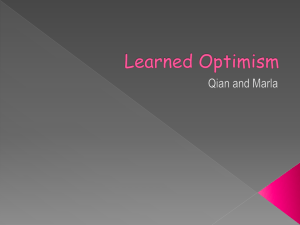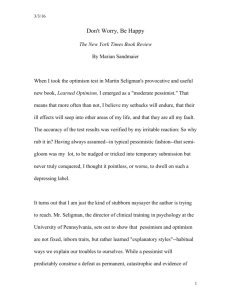Owner`s Manual for the Brain DEG 3-04
advertisement

The Owner’s Manual for the Brain by P. J. Howard Summary by D. E. Goldberg University of Illinois at Urbana-Champaign deg@uiuc.edu Text • Howard, P. J. (1994). The owner’s manual for the brain: Everyday applications from mind-brain research. Austin, TX: Leornian Press. • Director: Center for Applied Cognitive Studies, Charlotte, NC. PhD in Education UNC, Chapel Hill. Brain Science • Origins in WW2 & 1948 Hixon Symposium, “Cerebral Mechanisms of Behavior.” • Fields: – – – – – – Neurobiology Psychology Information Science Philosophy Antrhopology Linguistics Mind versus Brain • • • • Brain as power plant As computer As 2.8x1020 bits Principles: – – – – – Nativism: inheritance & environment Unity: brain-mind one Connectivity: essence of growth Interconnectivity: more or less Control: health if individual controls situation. Basics • Reptilian brain: Survival, respiration, digestions, circulation, and reproduction. • Leopard brain: Emotion and coordination of movement (GAS-Selye’s general adaptation principle). • Learning brain: Cerebral cortex. RAS and the Gap • RAS: Recticular activating system switches between limbic system and cortex. • Synaptic gap: gets dirty with protein buildup. • Neurotransmitters: 100 billion neurons with new synapse following learning. • Excitation and inhibition: Topics in Passing • • • • Sexual differentiation: Wiring not the same. Aging: Use it or lose it. Diet Mind-altering drugs Sleep • Cycle: 6-noon, blood clotting high, memory sharp, noon-6 pm smell better, body temp higher, grip strength highest. • Nap and live longer. • Dreams: Hobson activation-synthesis theory. Personality • Nature versus nuture • Equalizer theory of personality: – – – – – Intelligence-domains Traits intelligence-components Values motivators Five Factor Model • • • • • Resilience Extraversion Openness Agreeableness Conscientiousness Emotions • Modeling emotion: – – – – – Event Perception of event Appraisal of event Filtering the appraisal Reaction to the appraisal Appraisal Filter • • • • • • Goal relevance Goal conguence or incongruence Goal content Source of blame or credit Coping potential Future expectations Coping Styles • • • • Verbals Nonverbal Verbal and nonverb al Neither verbal nor nonverbal 3 Faces of Intelligence • Process: Sternberg, processes at work in intellect. • Content: Howard Garnner types of intelligence. • Structure: Eysenck, Gardner’s Domains • • • • • • Linguistic Musical Logical-mathematical Spatial Bodily-kinesthetic Personal • Criteria: – – – – – – – Isolation by brain damage. Prodigies Developmental uniqueness Evolutionary plausibility. Validation experiments. Psychometrics. Existence of symbol system to express its contents. Eysenck’s Correlates • Reaction time • Inspection time • Overage evoked potential Optimism versus Hardiness • Seligman (1991). Learned optimism. • Optimism: personalization (internal). Permanence, Pervasiveness. Reverse on adversity • Cousins (1989). Hardiness. – – – – Positive expectations Relaxation Positive emotions Active role Motivation • Extrinsic versus Intrinsic • Amabile’s indicators: – – – – Stimulated by task Sense of competence from task Task free of strong external control At play, not work Seligman’s ABCDE Model • • • • • Adversity Belief Consequences Disputation Energization Pygmalion Effect • Robert Rosenthal (1968). High potential, low potential groups. • High potential did better. But both groups were the same. Chunks • • • • Miller (1956). Seven bits of information. Testing is a learning process. Experts better than technques. Bartlett (1932). Schemas Learning • Hart’s environmental factors: – – – – High expectations Nonthreatening ambiance Goal of 100 percent mastery Air of reality • Advance organizers – Schemas in advance of learning Creativity • Amabile’s creative personality – Domain-relevant skills – Creativity-relevant skills – Task motivation • Creativity-relevant skills – Cognitive style: break perceptual sets, comfort with complexity, suspend judgment, see things differently – Knowledge of heuristics – Work style: long periods of concentration, persistence, hard work and high energy. Traits of the Creative • • • • • • • • • • • Self-discipline Delay of gratification Perserverance Independent judgment Tolerance for ambiguity Autonomy Absence of sex-role stereotyping Internal locus of control Willingness to take risks Self starter Absence of conformity Removing Obstacles to Creativity • Creativity assessment: http://www.creativelearning.com/A ssess/index.htm • Obstacles: – – – – – – – Critical nature Personality Diet Physical condition Fear Conflict style Highly developed superego – – – – – – – – Left-hemisphere dominance Conservative culture Closed end questioning Perceptual fixedness Need for power and control Pessimism Over/under achievement Time pressure Styles for Approaching Problems • Preserver: quick solution tried and true. • Explorer: innovative solution on new insight. • Challenger: truth based on logic • Adapter: harmony through consensus. Problem Taxonomy • Problems for which causes are known or not. • Solutions: Outcomes are certain or uncertain or prioritzed. Techniques • Mindmapping: Buzan (1991). Connect words and phrases. • Ishikawa or fishbone diagram. People, methods, machinery, & materials. • Pareto diagram. • Actual versus ideal diagram Brain-Philosophy Connection • • • • Epistemology: Philosophy of knowledge. Search and replace exercise Epistemology: similarities in structure. Kuhn: paradigm shifts Pemberton’s Stages • Permberton: Stages of semantic development: – – – – – Sensing Pre-science Early science Modern science Advancing science • Law of Noninvalidation – React genuinely – Paraphrase them – Question them Other Theories • Kohlberg – – – – – – Pleasure/pain Pragmatic Reciprocation Law and order Rational/legal Brotherly love • Piaget – – – – – – Sensorimotor Preoperational Concrete operations Concrete operations Formal operations Formal operations











